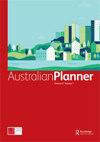Tiny houses and planning regulation for housing alternatives: the context of regional Victoria
IF 1.5
Q2 Social Sciences
引用次数: 1
Abstract
ABSTRACT The emergence of ‘Tiny Houses’ as a dwelling and cultural phenomenon reveals significant frictions with regulatory systems orientated towards orthodox housing models. In this regard the tiny house movement shares a genealogy with traditions of self-build housing and more recent sustainable and affordable housing alternatives. In each instance, regulatory frameworks have created points of resistance, including a planning system that differentiates between various categories of permanent and temporary accommodation. In regional areas such tensions are apparent in various forms; fluidity between temporary and permanent residential uses, unregulated self-building and the use of non-residential structures for housing. We position Tiny Houses as a category of these conflicts, arguing that the regulatory intent of restricting dwellings has a range of purposes in Victorian planning law, including the protection of farmland, the regulation of wastewater and the maintenance of housing standards. This paper will utilise Victorian planning decisions and definitions to consider the way in which non-conforming housing models have been addressed in rural settings and credibility given to claims of sustainability and innovation in housing provision within the broader decision-making framework. The results suggest that varied housing is enabled by the planning system, however category issues remain regarding mobility, permanence and impact.小房子和住房替代方案的规划监管:维多利亚地区的背景
摘要“小房子”作为一种居住和文化现象的出现,揭示了与传统住房模式的监管体系之间的重大摩擦。在这方面,小房子运动与自建住房的传统以及最近的可持续和负担得起的住房替代品有着共同的谱系。在每一种情况下,监管框架都会产生阻力点,包括区分各类永久和临时住所的规划系统。在区域地区,这种紧张关系表现为各种形式;临时和永久住宅用途之间的流动性,不受监管的自行建筑和非住宅结构的住房使用。我们将小房子定位为这些冲突的一类,认为限制住宅的监管意图在维多利亚州规划法中有一系列目的,包括保护农田、监管废水和维护住房标准。本文将利用维多利亚州的规划决策和定义,考虑在农村环境中解决不一致住房模式的方式,以及在更广泛的决策框架内对住房供应的可持续性和创新性主张的可信度。结果表明,规划系统能够提供多样化的住房,但在流动性、永久性和影响方面仍然存在类别问题。
本文章由计算机程序翻译,如有差异,请以英文原文为准。
求助全文
约1分钟内获得全文
求助全文

 求助内容:
求助内容: 应助结果提醒方式:
应助结果提醒方式:


